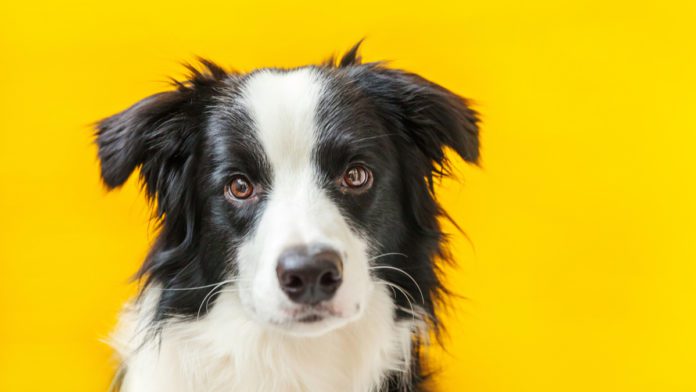Herniated Disc condition is also called intervertebral disc disease (IVDD) or slipped disc in dogs. This condition is characterized by the disc’s swelling or tearing between the small bones of the spinal column. When there is a compromise to these discs, it can press on the spinal cord and cause pain along the area of body tissue supplied by the nerves. In some cases, the disc may split open and its contents expelled, causing inflammation to surrounding tissues. The slipped disc is the most common cause of paralysis in dogs.
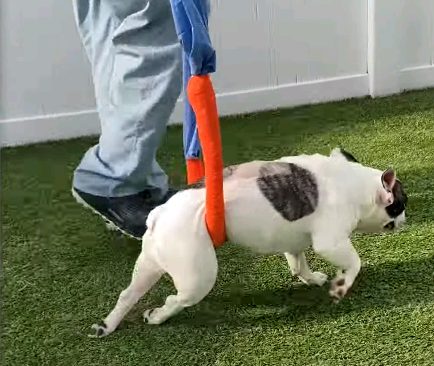
Causes of Herniated Disc In Dog
In general, as your dog grows, its chances of having a slipped disc increase. A 5-year-old dog is more predisposed to this condition than a two-year-old. Dog breeds like Dachshund, Bulldog, Beagle, Corgi, Shih Tzus are most commonly affected. However, specific causes for a canine herniated disc include the following;
- Premature degeneration of the intervertebral disc
- Thickening and protrusion of the annulus fibrosus
- Trauma
Premature Degeneration of Intervertebral Discs
Chondrodystrophic breeds of dogs characterized by short legs are mostly the ones being affected. The Intervertebral discs lose their ability to retain water, and the nucleus pulposus becomes dehydrated and later calcified. Thus, the discs lose their shock-absorbing property and cannot adjust to the compressions that usually accompany the dog’s normal living.
These forces strain the disc, making it tear and allowing the nucleus pulposus to herniate, usually upward through the defect and pressing on the spinal cord. This disease is common in small dog types above two years of age. However, the severity depends on the spinal cord’s impact than on the mass of the disc contents extruded.
Thickening And Protrusion Of The Annulus Fibrosus
This occurs majorly in non-chondrodystrophic dogs. When the annulus fibrous thickens and bulges because of degeneration, it can press on the spinal cord. Signs of Intervertebral discs disease appear insidiously. The annulus fibrous may tear acutely on several occasions, and the nucleus pulposus herniates, producing signs similar to Hansen’s type 1 disc disease. Medium-size to large-size non-chondrodystrophic breed dogs ranging from above five years to not more than 12 years are more likely to be spoken for.
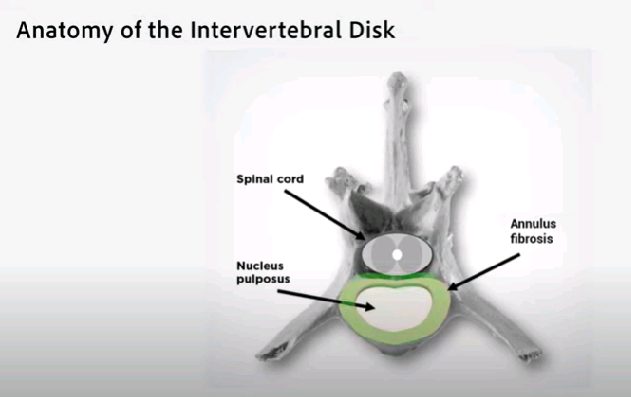
Trauma
A sudden forceful impact to the dog’s spine anywhere from the cervical to the lumbar region can cause disc herniation. It causes the normal disc to burst and protrude the nucleus pulposus from a sudden split in the annulus fibrosis.
Herniated Disc Symptoms In Dog/ How To Identify
It depends on the cause of the disc herniation and the site of the condition; the signs and symptoms of intervertebral disc disease vary, with some similarities in between. These signs and symptoms are caused by the spinal cord’s pressure, inflammation of surrounding tissues, or damage to associated nerves.
The accompanying signs also depend on the severity of the impact. It could range from just a simple back pain to complete permanent paralysis. Pain is one of the common and general accompanying features of a slipped disc, and it manifests in several ways.
Pain may be felt at the neck or the back, depending on the location of the herniated disc. There can also be muscle spasms, neck stiffness, loss of pain sensation and permanent paralysis, and difficulty breathing in severe cases. Clinical behavioral changes are also seen in dogs affected by a slipped disc, and they manifest in the following ways;
- Shivering
- Crying when touched or picked up
- Diminished interest to run or play
- A repeated unusual gait
- Weakness
- Dragging of back legs
- Increased sensitivity to touch and movement
- Urinary incontinence/ urine dribbling
- Fecal incontinence
- Limping when walking
- Inability to support body weight
- Wobbliness of all four legs
- Panting
How To Treat Herniated Discs In Dogs
Choosing a treatment plan for your dog with a slipped disc depends on the degree of the condition. At the onset of noticing symptoms, you may ensure that your dog goes on a full strict thirty-day cage rest. This is to prevent further protrusion of the herniating disc and further damage to the spinal cord and nerves.
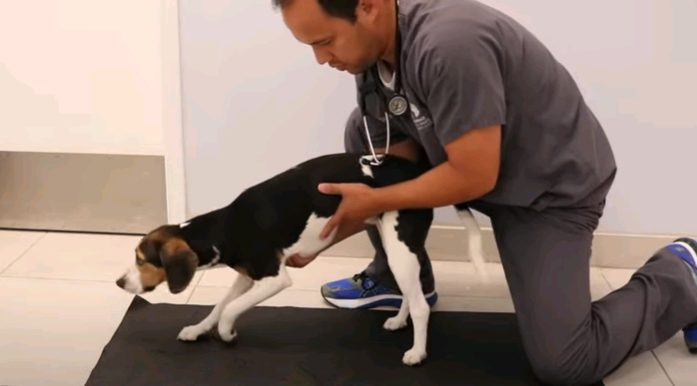
In less severe cases, medications can be prescribed by a veterinarian. These medications are anti-inflammatory drugs to reduce the feeling of pain your dog is experiencing, reduce swelling and relax your dog’s muscles. Surgery may become the only effective treatment when the condition has become very severe. They are several surgical procedures to fix a slipped disc, and they include the following;
- Hemilaminectomy
- Ventral slot
- Pediculectomy
- Dorsal laminectomy
- Fenestration
Hemilaminectomy is an invasive surgical procedure to remove part of the lamina (a plate of small bone found in the vertebra) to reduce pressure on the spinal cord. The ventral slot is done when the herniated disc is in the front of your dog’s neck. Pediculectomy is similar to hemilaminectomy. Here the pedicles (also a part of the vertebra) and not the lamina are surgically removed to decompress the nerves winding around during a slipped disc.
Fenestration removes the nucleus pulposus from the affected intervertebral disc and reduces the decompression of the spinal cord. After treatment, your dog may need physical therapy to re-establish its original locomotive abilities, and you may be required to keep track of your dog’s weight over time.
Herniated Disc Treatment
A herniated disc can progress to partial or total paralysis if left untreated. Also, it is usually accompanied by moderate to severe levels of pain. Surgical intervention is usually discussed upfront, but some dogs can recover without any surgical intervention using a conservative treatment plan. This is a good option if cost is a major consideration for pet owners.
Conservative Management
Conservative treatment can allow improvements and restore motility and body functions within six to twelve weeks. The duration depends on the breed of the dog and the severity of the herniation. It involves:
- Crate/cage rest: The cage is made to limit the dog’s movements, and it should allow the dog turned from side to side to ensure proper healing.
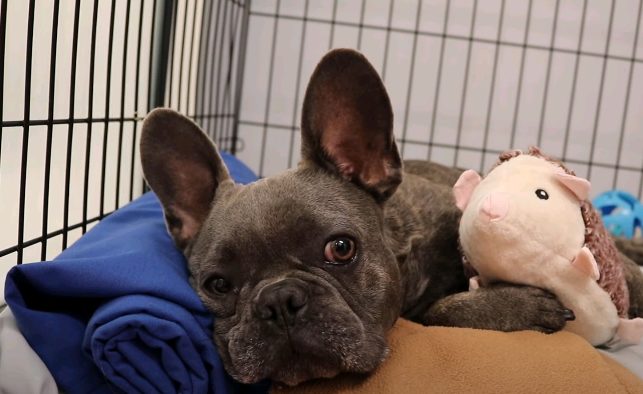
- Maintenance of bodily functions: This involves ensuring that the dog is eating and drinking enough food materials. Due to the amount of pain the dog is in, he may find it difficult to pass urine or defecate. Holding urine or stool for long periods can have detrimental effects and even lead to other complications. Stool softeners are usually used.
- Drugs: This typically includes over-the-counter pain medication, muscle relaxants, and sedatives, as well as a steroidal, anti-inflammatory drug. Your dog might also need some drugs to maintain gastroenteric function in addition to the stool softener.
Surgery
In the surgical treatment of disc herniation, a portion of the vertebrae over the spinal cord is removed. This is done to reduce the pressure on the spinal cord and nerves. The exact surgical procedure varies with the location of the herniation. The two most common procedures are:
(a) A ventral slot – in the neck, or
(b) a hemilaminectomy – in the thoracolumbar region.
Before the surgery, there is a need for an MRI scan. This is necessary to determine the exact location of the herniation. It is important to note that X-rays and CT scans cannot visualize the neural tissue of the spinal cord. Another alternative that some vets prefer is a myelogram.
After surgery, the dog will remain hospitalized for a few days, during which pain medication and relaxants are administered. When the dog is taken home, he will usually require four to six weeks of crate rest. During this time, urine and feces may need to be expressed manually. Also, food and water should be placed within easy reach of the dog.
Physical Therapy
Physical therapy aims to restore motility as much as possible. This involves a series of exercises to strengthen the muscles of the limbs and keep the joints mobile. You can begin physical therapy immediately after the surgery.
It is best to consult with a therapist to decide the best routines for your dog. Some therapy will require a visit to the therapist, but the pet owner is usually required to perform some routines with the dog daily because it aids in fostering a close bond between the pet and its owner(s).
Some of the tools that a therapist might recommend for your dog are wobble boards and balance discs. Laser Therapy and massage are often beneficial to reduce pain and stiffness in the dog.
Braces
A brace is a device that helps to keep the dog’s back straight. This can help perform the following functions;
– Reduce pressure on a herniated disc
– Aid recovery from disc herniation
– Prevent disc herniation
Exercises for Herniated Disc in Dogs
Several different exercises may be prescribed for a dog that has had a disc herniation. Here are a few of them
- Passive Range of Motion: this should only be attempted when the permission of the therapist. Here, the dog is laid on its side. Hold its foot, and move the limb in a circular motion, like riding a bicycle. Ten to fifteen repetitions twice or thrice daily.
- Toe pinching: is a good exercise to check if the neurological function is preserved. Pinch between the toes gently until the dog kicks his feet.
- Leg extensions: this is done to stretch the muscles of the legs. First, the legs are drawn backward, then hold for twenty seconds. Then draw the legs forward and hold for twenty seconds.
- Strike a match: with the dog standing, lift a leg, then gently use the foot to stroke the floor—ten repetitions on each leg.
- Foot compressions: with the dog lying on its side, the leg is folded back, flexing all the joints on the limb. Repeat for the other leg.
Cost Of Treatment
Of course, getting your dog to rest for a few weeks would cost you little or nothing. Getting medications for your dog will cost you some money but much less than you would put in for surgery. At first, an indication for an imaging study will require you to pay money, which can cost around a thousand US dollars to three thousand US dollars.
The actual cost of the surgery is between one thousand five hundred US dollars to four thousand US dollars. The above costs may vary depending on where you live. But because of the bond you share with your buddy, you may agree to carry out such bizarre life-saving procedures and see to it that they get back on their feet and continue to lead normal lives.
Natural Remedies for Herniated Disc
In the treatment of disc herniation, some drugs may have certain unpleasant effects. Also, some drugs may not be appropriate for some pets. These and other concerns have prompted veterinary doctors and therapists to seek natural remedies. Here are some of the more effective ones
- Chiropractic care: chiropractors ease neuromuscular pain and disorders by manual manipulation and adjustment of the spine. Veterinary chiropractors are usually of great benefit to pets with disc herniation. They greatly relieve pain and, in some cases, are said to cure disc herniation.
- Acupuncture: is a Chinese practice of relieving pain by inserting needles into specific points on the body. This practice can also relieve pain from disc herniation. A variation of this is electro-acupuncture. In this procedure, small pulses of electricity are passed into the body through the needles to relieve pain. An expert should only perform acupuncture and electro-acupuncture.
- Physical and massage therapies: these involve exercises, massages, applications of heat. The aim is to ease movement and increase blood flow. Hydrotherapy is similar to physical therapy except that the exercises are performed in the water.
- Homeopathy: is a treatment method whereby a substance can induce clinical symptoms of the illness being treated. This induces the body to develop a coping defense.
- Herbal remedies: these are the plants and plant extracts used to relieve pain and treat diseases. Herbal treatments are known to be very effective in relieving the pain due to disc herniation. These herbal remedies should be prescribed by a professional.
Herniated Disc Prevention
Although there are many treatment options for dogs with disc herniation, disc herniation causes long-term damage that can only be managed but never completely eradicated in most dogs. This debilitating condition can be prevented by taking certain precautions:
- Weight control: Obesity is one of the major contributing factors to disc herniation. Excess weight, especially around the shoulders and trunk, can pressure the dog’s back and neck, increasing the risk of disc herniation.
A sedentary lifestyle and an uncontrolled diet are key causes of obesity. To keep your pet healthy, ensure it gets enough regular exercise. Also, low-calorie alternatives should be found for your pet’s meal, and treats should be regulated.
- Use a harness to aid the movement of your pet. This is because the leash distributes weight more evenly and reduces the neck’s stress than a leash. This can reduce the risk of disc herniation in the neck.
- Discourage actives that can cause sudden disc herniation like jumping and running very fast. Also, use of ramps and lower stairs for susceptible dog breeds to reduce the need to jump.
- Handle with care when lifting or carrying your pet. Ensure that you support both the shoulders and the hips. Lifting your dog from behind his front legs, with his hips and back legs hanging, can increase the risk of disc herniation.
- Trace your breeder’s ancestry. Disc herniation can be passed down hereditarily, so take care when breeding your pet. Always ask and ensure that the dog you’re breeding your pet with does not have a familial history of disc herniation.
- Regular check-ups. Schedule regular visits to the vet at least once or twice a year to have your pet checked out. Regular check-ups are vital if your pet is one of the breeds prone to disc herniation.
- Use of a dog brace: can keep the back straight and prevent disc herniation.
Conclusion
In conclusion, disc herniation is a neurological disorder in which the inner part of the intervertebral disc slips out and presses on the spinal cord. It’s quite common in certain breeds of dogs that have short legs and long torsos. It also occurs in larger dogs with age, and obesity increases the risk in every dog breed.
Treatment of disc herniation is either conservative or surgical intervention. The use of braces can reduce the symptoms of disc herniation and can prevent it. After treatment, therapy is needed for a full recovery. Thus therapy usually involves certain exercises. These are recommended by the veterinary therapist to be done during visits to the clinic and at home.


